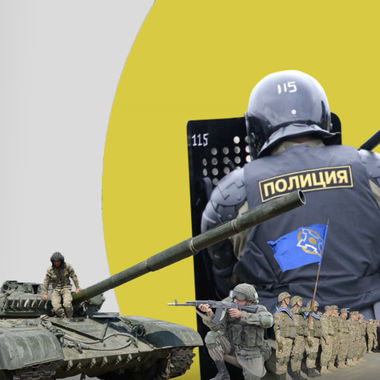Understanding the Region: The Caucasus and Beyond
Understanding the Region: The Caucasus and Beyond is a ten-part series of special reports that will provide credible, fact-based information and awareness about a wide range of regional topics and issues impacting the South Caucasus. The purpose of this series is to provide clarity and understanding of regional dynamics and interrelations.
Introduction
The Eurasian Economic Union (EAEU) was established in January 2015 and was aimed at creating a shared economic space with a single customs union and integrating states into a new cohesive economic entity. A more advanced iteration of the Eurasian Customs Union, founded in 2010 with Russia, Belarus, and Kazakhstan, the EAEU was established when Armenia and Kyrgyzstan joined on January 2, 2015 and August 6, 2015, respectively.
While the EAEU is the first such economic union in the post-Soviet space, countries outside the region, such as Iran and Mongolia, are also being courted to join.
While Russia’s primary aim of Eurasian integration has been to more effectively project its power globally, other member states have been less interested in pursuing deep integration. This is evident from the significant institutional deficiencies within the EAEU, most notably, the lack of common Eurasian Economic institutions which render the organization ineffective in the medium to long term.
Aims and Limitations
The EAEU has been touted by Eurasian leaders, including Russian President Vladimir Putin, as a counterpart to deep, European Union-style integration. Delegating competencies to common institutions, however, entails a significant renouncing of sovereignty by member states, as the union establishes an authority structure that is, nominally, supposed to supercede national structures. Efforts at ensuring accession of member states through ad hoc gestures of generosity such as lower energy prices, however, presents an obstacle to a genuine, rules-based union. Furthermore, as individual members have been less than enthusiastic about membership in the EAEU, Russia’s response of institutional flexibility and weak formal commitments has facilitated membership, but has also left the long-term durability of the union in doubt.
As a union, the EAEU comprises several governing bodies with equal representation of members. These are the Supreme Council – consisting of the heads of state, the Intergovernmental Council – consisting of heads of government, and a two-tier Eurasian Economic Commission. The upper body, the Eurasian Economic Commission (EEC) Council, includes deputy heads of government, and the lower body, the EEC Collegium, comprises ministers nominated by member states. All bodies make decisions by consensus, except the EEC Collegium, which adopts acts with a two-thirds majority.
The overall quality of governance across EAEU member states is low. In particular, EAEU member states are generally characterized by low standards of legal culture and a poor commitment to rule of law. Member states’ political elites are largely unaccustomed to political accountability, and little consideration is given to compliance within member states. Therefore, the task of creating supranational structures with better governance capacity than national institutions is a challenge (EBRD Transition Report, 2012).
The poor governance that characterizes EAEU states threatens the effective functioning of the union as a rules-based regime. Yet simultaneously, the EAEU abstains from promoting the rule of law in the way the EU does. The EAEU actually seeks to ensure that integration ‘respects the specificities of the political order of its member states’ (Treaty on the Eurasian Economic Union, 2014). While the current mode of decision-making offers a great deal of flexibility to member states to tailor their integration, the lack of formally binding provisions limits the scope of Eurasian integration.
Priorities of integration
The Union comprises a framework for integration that includes the creation of a common market without internal barriers. This entails the removal of non-tariff barriers and establishing common markets in energy, industry, and agriculture, as well as the harmonization of various domestic policies. Such an agenda arises from the acknowledgment that the benefits of preferential trade agreements emerge from deep integration. Such an ambition, however, requires strong domestic institutions and a high level of cooperation. In reality, this integration is hampered by the desire for flexibility by member states.
The EAEU treaty, signed in May 2014 by leaders of Russia, Belarus, and Kazakhstan, declares that member states can trade with one another without tariffs, non-tariff barriers or other internal customs controls. Things become more complicated, however, when it comes to border trade and the elimination of domestic regulatory and other non-tariff barriers to trade. While the provision of common border regulation was achieved through the adoption of a common customs code, that code resulted in complex customs regulations because of the references to national legislation – something that was heavily criticized by businesses (Dragneva and Wolczuk, 2017). A new code was adopted in December 2016 to resolve this. Non-tariff barriers, however, remain a significant obstacle to free trade in the EAEU.
Further integration is also hindered by new obstacles to free trade. Most well-known are the ‘trade wars’ (see The Moscow Times, 2015; Radio Free Europe/Radio Liberty, 2018) between EAEU member states. These disputes exhibited problems with regards to the invocation of exemptions to free trade based on allegations of food safety standard violations. These battles at the very least signify a lack of certainty in trade relations.
Members
The EAEU is a project steered by Russia to engage with post-Soviet countries and the benefits to Russia are more political than economic. Trade with EAEU member states, for example, accounted for only 5 percent of Russia’s overall trade (Dragneva and Wolczuk, 2017). Russia’s initial intentions were to establish a more comprehensive union that encompassed a unified monetary regime, as well as political and defense integration. This more extensive plan was rejected by other states – in particular Kazakhstan, which was able to limit the EAEU to economic integration (Dragneva and Wolczuk, 2017). While members had good reasons to join the EAEU, thus allowing the union to expand, the union arguably benefits Russia the most, allowing it to respond to the challenge of a powerful EU with a similar regional union in Eurasia. The EAEU also fulfils an implicit role as the Eurasian alternative to the EU – a framework for imposing on neighbor states a geopolitical choice between the West and Russia.
For Belarus, better access to the Russian market has been the greatest appeal of membership. Given Belarus’s dependence on imports from Russia, achieving favourable terms for energy imports has determined Belarus’s decision to seek closer cooperation with Russia. In particular, Belarus relies on Russia’s oil and gas.
In Armenia’s case, security and economic imperatives have determined its EAEU membership. Highlighting Russia’s bargaining strength, Russia forced Armenia to overturn its previous decision to stay outside the union. After a brief meeting with Putin in September 2013, however, Armenian President Serzh Sargsyan unexpectedly announced Armenia’s intention to join the EAEU. Such an outcome was unexpected and surprising – even to Armenian political elites, given that Armenia had been in negotiations with the EU to sign the Association Agreement for years and had completed the negotiations just weeks prior to the U-turn, intending to sign on in November 2013. While Russia provided economic enticements to Armenia such as reduced energy prices, Armenia’s need for security guarantees in its long-standing conflict with Azerbaijan compelled its membership.
Kyrgyzstan’s important trade relationships with Russia and Kazakhstan were the main motivating factors in its decision to accede to the union. As a high ratio of the country’s GDP comes from remittances from migrant labor in Russia, having access to the Russian labor market as well as receiving Russian financial assistance were important motivating factors for membership.
Kazakhstan, desiring more free trade and economic cooperation sees the EAEU as a way to contain Russia within a rules-based organization and restricts its integration to economic issues rather than a totally political union.
Ukraine is not a member, but its participation was seen as crucial for the EAEU to function as a fully fledged regional alliance. Ukraine, like Armenia, had been in talks with the EU to sign on to the Association Agreement. When Ukraine’s economy began entering a recession in late 2013, a much desired financial package and low energy prices from Russia swayed then-Ukrainian President Yanukovych, who failed to sign on to the Association Agreement. This generated mass anti-government protests, eventually resulting in Yanukovych’s fleeing to Russia. Consequently, as Ukraine moved to forge stronger ties to the EU, Russia responded with retaliatory measures, annexing Crimea, and introducing Russian troops in Ukraine’s eastern Donbass and Lugansk regions, demonstrating the political and military costs of going against Russia.
Conclusion
The EAEU as a project is hindered by a lack of commitment from its member states. While member states enjoy a large degree of bargaining power and flexibility, as a Russia-led project, their authority is easily curtailed when Russia’s broader objectives are at stake.
The real economic benefits of the EAEU come primarily from removing non-tariff barriers which hinges on the modernization of member states’ domestic institutions. Russia has seemed more intent on forming the union than it has in the development of strong supranational institutions. The dynamics of integration are thus far inconsistent with the stated premise of the union: that it is not a Russian project for increased regional influence but is rather a legitimate project of regional economic integration.
Despite its multiple shortcomings, the EAEU should not be underestimated. The union is a significant tool for Russia to project its power regionally and globally. While member states might receive only modest economic benefits, an exit – while theoretically possible, would be a risk given the experience of Ukraine. Thus, the Eurasian project is likely to move forward with ups and downs and continue to be promoted as a Eurasian alternative to the EU.
also read
Fact Sheet: What is the Collective Security Treaty Organization?
By Karena Avedissian
This Fact Sheet about the Collective Security Treaty Organization is part of a larger project, “Understanding the Region: The Caucasus and Beyond.” It explains what the purpose of the military alliance is, what membership entails, its weaknesses and more.
--------------------------------
References
Dragneva, R. and Wolczuk, K. (2017). The Eurasian Economic Union: Deals, Rules and the Exercise of Power. Chatham House. [online] Available at: https://www.chathamhouse.org/sites/default/files/publications/research/2017-05-02-eurasian-economic-union-dragneva-wolczuk.pdf
EBRD (2012). Integration Across Borders: Transition Report. [online] Available at: https://www.ebrd.com/downloads/research/transition/tr12.pdf
The Moscow Times (2015). Trade War Mounts Between Russia and Kazakhstan. April 13. [online] Available at: https://www.themoscowtimes.com/2015/04/13/trade-war-mounts-between-kazakhstan-and-russia-a45711
Radio Free Europe/Radio Liberty (2018). Belarusian Leader Has Harsh Words for Russia, West – and Warning for Moscow. April 24. [online] Available at: https://www.rferl.org/a/belarus-lukashenka-has-harsh-words-for-russia-west--and-warning-for-moscow/29189360.html
Treaty on the Eurasian Economic Union (2014). [online] Available at: https://www.un.org/en/ga/sixth/70/docs/treaty_on_eeu.pdf
Opinions expressed in this publication do not necessarily represent those of the Black Sea Trust or its partners.






EVN Report welcomes comments that contribute to a healthy discussion and spur an informed debate. All comments will be moderated, thereby any post that includes hate speech, profanity or personal attacks will not be published, including abusive, threatening, racist, sexist, offensive, misleading or libelous language. Comments deemed to be spam or solely promotional in nature will not be published. Including a link to relevant content is permitted, but comments should be relevant to the post topic.